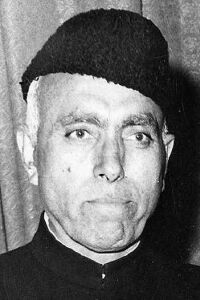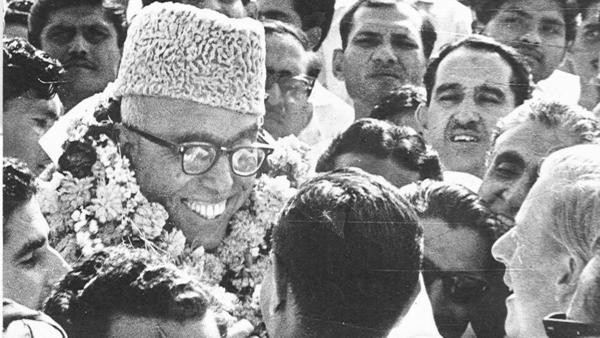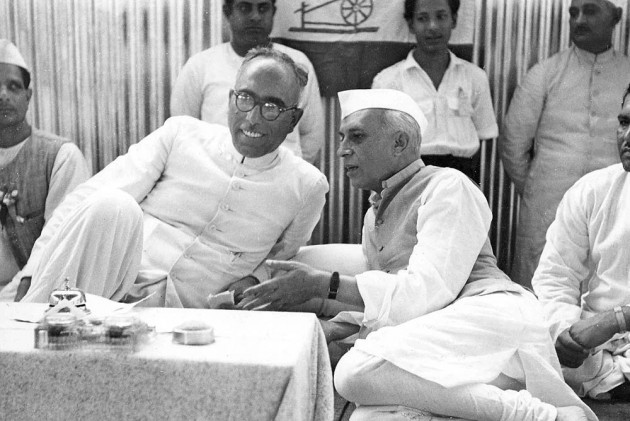The story of Kashmir makes a great Case for History. It connects Past with Present and Future in deeply meaningful ways.
To understand the problem of Kashmir, it is necessary to know the story – the full story. In Part I of this series, I had narrated the backdrop to the story. (Click here to read Part I, if you haven’t already.) This part takes off from where we left in Part I.
In the last part, I had introduced you to two key players in the story of Kashmir. Maharaja Hari Singh , the last Dogra Ruler of Jammu and Kashmir and Lord Mountbatten, the last Viceroy of India.
Let’s now meet another key player – Sheikh Abdullah, one of the tallest leaders of the valley.

Sheikh Abdullah is a key player in the story of Kashmir
Abdullah was born to a middle-class shawl trader in Kashmir. A product of Aligarh Muslim University, during his youth, he had been exposed to liberal and modern ideas at college. He strongly felt that peasants ought to own land in Jammu and Kashmir in order to have a more just and egalitarian society.
Sheikh Abdullah founded a party called the Muslim Conference (later called the National Conference), whose aim was to work for the upliftment of the people of the state. In this role, he had clashed with Maharaja Hari Singh, who was the monarchical head of the state. But the clashes would become more intense as the 1940s rolled on.
Naya Kashmir
In 1946, Sheikh Abdullah stared a movement called Quit Kashmir. While Mahatma Gandhi had launched the Quit India movement in 1942, demanding that the British leave the country, Abdullah started the movement with a similar clarion call – except this one was not targeted at the British, but at the Maharaja, whose regime the Shaikh claimed was corrupt and dictatorial.
Two years earlier, he had called people to come together to build a Naya Kashmir – a New Kashmir, built on principles of equality and democracy. He had submitted a Memorandum to the Maharaja, asking that the monarchy be turned into democracy and various reforms be introduced including rights for women. With no change, the Shaikh now demanded that the Maharaja leave Kashmir.
The movement picked up storm. Many joined his call for Naya Kashmir. He formed the Abdullah Guards for the protection and help of the ordinary people. Men and women, young students – they all joined him. He urged his own wife to give up wearing the burkha and throw herself into the movement. She did. As did many others across the state.

Sheikh Abdullah was very popular amongst the people of Kashmir
Maharaja Hari Singh responded by arresting Shaikh Abdullah. In 1946, when India was on the eve of independence, Shaikh Abdullah was put in jail.
History-in-the-making
Meanwhile, History was in the making. The British Empire was being dismantled and was set to withdraw from its most prized colony.
This was roughly the same time Jinnah’s call for Pakistan was gaining storm in the rest of India. What had once been dismissed as a mad dream of a fanatic had become a threat and was soon appearing to become a reality.
The two-nation theory was based on the principle that Muslims and Hindus were two distinct nations. Jinnah and the Muslim League had assumed that Kashmir, being a Muslim majority state, would go to Pakistan. In fact, when the idea of a new nation was propounded, the name Pakistan was coined by including the various states imagined as the separate homeland – and the letter K in Pakistan stood for Kashmir.
But Kashmir was ruled by a Hindu Raja. And the formula was to be that the ruler of the princely state (Nawab/Nizam/Maharaja/Maharana..whatever the case maybe) would take the call on whether to join India or Pakistan or remain free. The decision was in the ruler’s hands.
Stacking up the Odds
Now that we have the setting and some of the key players, let’s see how they stack up against one another.
Nehru, the Interim Prime Minister of India in 1947, was a Kashmiri. He had a personal interest in Kashmir, which he admitted in a speech he later made in Parliament.
Jinnah obviously wanted Kashmir too. It was a Muslim majority state. He imagined it as a part of his new homeland. As mentioned earlier, the letter K in Pakistan stood for Kashmir. The idea of Pakistan for the Muslim League, was incomplete without Kashmir.
Maharaja Hari Singh, in whose hands the decision rested. was a Dogra Rajput – a Hindu. How could he ally with a state founded as an Islamic nation? But he was also a monarch. How could he throw in his lot with a nation that was to be fiercely democratic? Neither prospect seemed attractive to him. As it turned out, he wanted to join neither India nor Pakistan.
While the Maharaja disliked both Jinnah and Nehru, Nehru, on his part, had a deep dislike for the princely order. He had no love for the Maharaja or his Prime Minister, Pandit Kak. Jinnah on the other hand, would send out conciliatory messages to woo the Maharaja.
Shaikh Abdullah, the popular leader of the state, was a Muslim. But he was fiercely secular and had no love for Jinnah’s idea of an Islamic state. He was a great friend of Nehru’s and they both respected one another. While Abdullah disliked Jinnah’s idea of Pakistan, Jinnah too reciprocated his contempt for Adbullah.

Sheikh Abdullah was close to Nehru and the Congress. In fact, Nehru had gone to Srinagar to argue Sheikh Abdullah’s case in court when Maharaja Hari SIngh had the Sheikh arrested in 1946. The Maharaja’s Prime Minister Kak disallowed Nehru from entering the valley. Nehru felt bitter about that experience.
Such was the political scenario in 1947 when the drama began to unfold. Deeply complex and full of hopes, ambitions and intrigue.
How would these inter-relationships play out in the time to come? Who would ally with whom? How would the deck finally stack up? How would other historical events outside Kashmir influence the tide? Stay tuned for Part III to know what happened next.
Sign up to the Site so you can catch up on fascinating stories from Indian History and Culture!
566
The Dramatic Story of India’s Unification
My Book with Hachette Publishing House, will be narrating for the first time, the saga of Accession by Princely States, for Children. Including the Story of Kashmir.
Stay Connected to Stay Posted.

Trackbacks and Pingbacks